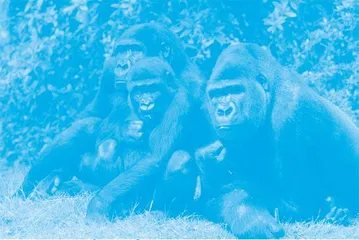Gorilla Study Reveals New Connection
作者: British Council

Humans and gorillas shared evolution for 23 million years. Their paths separated only six million years ago. Research on how gorillas communicate can help us understand human language development.
Understanding how the brain works helps us see a connection between language development and non-verbal signs. These signs or movements include things like the way we move our hands or bodies or the different expressions our faces have in different social situations. A new study on gorillas revealed that right-handedness – preferring to use the right hand instead of the left hand for most physical activities – may have a connection with communication.
Two cameras were used to film all of one ape’s movements. One of the first results was that gorillas use their right hands more when they are doing actions with their heads or mouths at the same time. This shows that there is a connection between how our brains work and the reason we use one side of our body more than the other. In addition, we can use the results of the study and our knowledge about brains to help us understand more about how language first developed in humans.
Dr Forrester, who did the study, says the results can be useful in other ways, such as understanding language development in children. For example, some children have a serious illness called ‘autism’ which can stop them communicating normally with people. It might be possible to use the same study method to find out which children have this illness when they are very young. Doctors will then be able to start treatment early.
This simplified version by Andreea Pulpea, adapted from the original article by John O’Reilly.
Activity 1
Before you read, match the word to a definition.
1. connection 2. evolution 3. expression 4. physical
5. reveal 6. separate 7. treatment
a. go different ways
b. show information to others
c. the way in which living things change and develop over millions of years
d. the way one thing affects another thing, for example smoking and illness
e. the way someone’s face looks which shows how they are feeling or what they are thinking
f. to do with the body
g. using drugs or exercise to make a sick person better
Activity 2
Read the text and choose the best answer from a, b or c.
1. When did the evolution of gorillas and humans separate?
a. more than 5 million years ago
b. 7 million years ago
c. It’s not known.
2. Right-handedness in apes may have a connection with …
a. intelligence.
b. communication.
c. social success.
3. The study can help us …
a. find communication problems early on.
b. make people use their right hands more.
c. develop language abilities in children.
4. The research team used …
a. video recording.
b. photographs.
c. audio recording.
5. The results of the study might help …
a. everyone.
b. sick apes.
c. children with an illness.
Activity 3
A. Look at the underlined verbs in sentences 1 and 2 and answer the questions.
1. Two cameras were used to film an ape.
2. Humans and gorillas shared evolution for 23 million years.
a. Who used the cameras? Who shared evolution?
b. In which sentence is the grammatical subject the same as the person(s) who did the action?
c. How is the form of the verb different in the two sentences?
B. Complete the sentences with the correct form (passive or active) of the verb in brackets.
1. This medicine ______ (use) in the treatment of many diseases these days.
2. Gorillas ______ (use) sticks to find ants in the forest.
3. This patient ______ (treat) in our hospital two years ago.
4. A research team ______ (discover) a new plant in the jungle in 2014.
5. Two people ______ (injure) in the car crash yesterday.
Activity 4
Are you right-handed or left-handed? Do you think left-handed children should be encouraged to become right-handed?
What is the best way for parents to help their children learn to talk?
Is it fair to do research on animals to help find treatments for humans?
Answers
Activity 1
1. d; 2. c; 3. e; 4. f; 5. b; 6. a; 7. g
Activity 2
1. a; 2. b; 3. a; 4. a; 5. c
Activity 3
A. a. Dr Forrester’s team; humans and gorillas; b. 2; c. 1 ‘be’ + past participle; 2 past simple
B. 1. is used; 2. used; 3. was treated;
4. discovered; 5. were injured